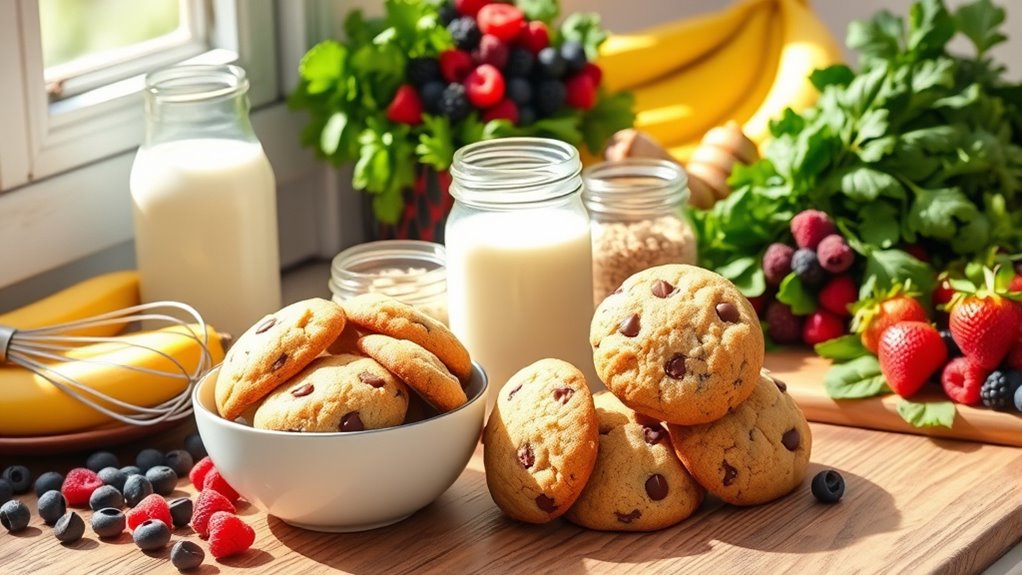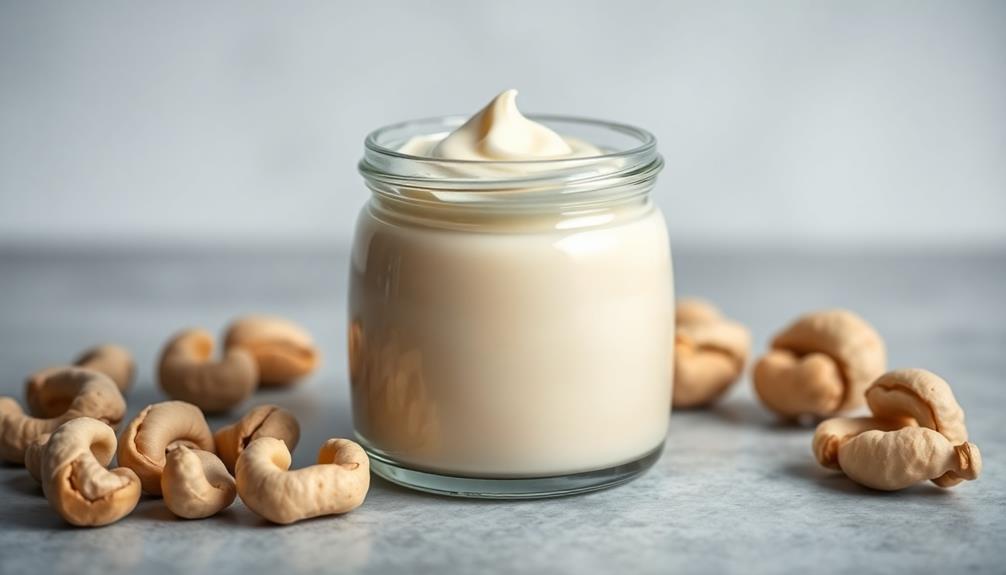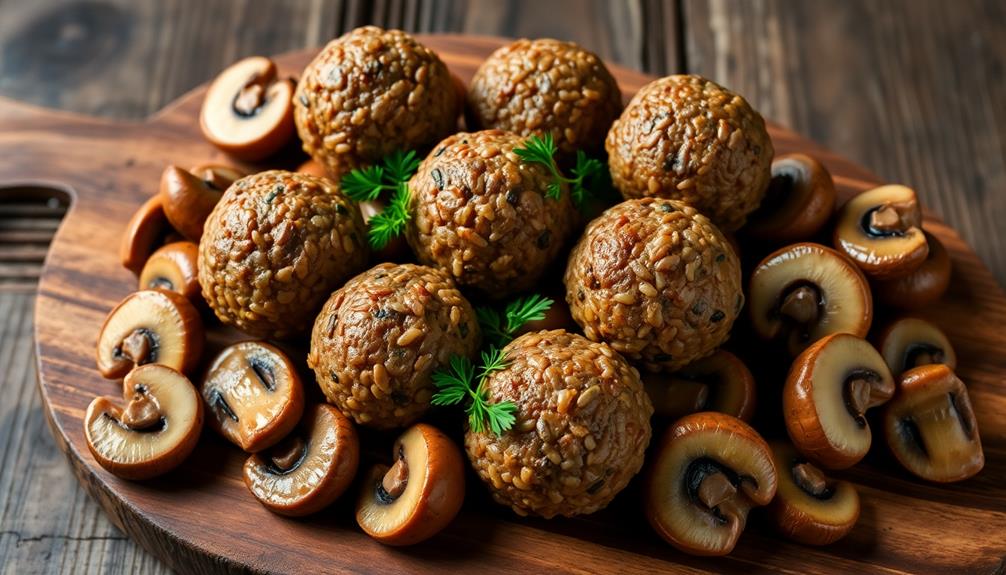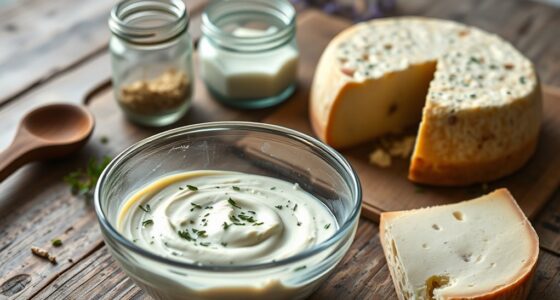To bake without eggs or dairy, you can use plant-based substitutions like vinegar combined with baking soda for leavening, or mashed bananas and applesauce for moisture and binding. Flaxseed or chia seed gels work well as egg replacers, while aquafaba can mimic egg whites in meringues. These options guarantee your baked goods stay fluffy and tasty, all while keeping your recipes vegan. Keep exploring to discover more effective and tasty swaps for your baking needs.
Key Takeaways
- Use plant-based leavening agents like vinegar with baking soda or cream of tartar for fluffy, airy baked goods.
- Replace eggs with flaxseed or chia seed gels, mashed bananas, or applesauce to add moisture and binding properties.
- Incorporate aquafaba, the liquid from canned chickpeas, to achieve meringue-like textures in vegan baking.
- Choose suitable substitutes based on recipe type, such as bananas for lighter baked goods or flaxseed for dense items.
- These vegan replacements maintain structure, leavening, and flavor, enabling versatile, egg- and dairy-free baking.

Have you ever wondered how to replace traditional ingredients in your favorite recipes to make them vegan? When it comes to baking without eggs or dairy, knowing your options for plant-based leavening and egg replacer alternatives can make all the difference. These substitutions aren’t just about making recipes vegan—they can also improve the health profile of your baked goods and introduce new flavors and textures. Whether you’re making muffins, cakes, or pancakes, understanding how to use plant-based leavening agents and egg replacers will help you achieve the perfect rise and moisture.
Plant-based leavening is a great starting point. Baking soda and baking powder are common leaveners, but when you want to keep your baked goods entirely vegan, you might consider natural alternatives like vinegar combined with baking soda or cream of tartar. These ingredients produce carbon dioxide, which creates the lightness in your baked items without animal products. For example, a teaspoon of apple cider vinegar or lemon juice mixed with baking soda can effectively replace traditional eggs in recipes that require leavening. These options are straightforward, readily available, and reliable, giving your baked goods that airy, fluffy texture you’re aiming for.
Vinegar and baking soda create natural, vegan leavening for light, fluffy baked goods.
When it comes to egg replacer options, there’s a wide variety suited to different recipes. Commercial egg replacers, made from ingredients like potato starch, tapioca, or flaxseed, are convenient and easy to use. Flaxseed meal mixed with water creates a gel-like consistency that mimics eggs in baking. Simply combine one tablespoon of ground flaxseed with three tablespoons of water and let it sit until it thickens. This works well in dense baked goods like muffins and cookies. Chia seeds can be used similarly, providing a slightly different flavor but equally effective binding qualities. For lighter recipes like pancakes or sponge cakes, mashed bananas or applesauce also serve as excellent egg alternatives, adding moisture and sweetness without compromising the texture.
In addition to these options, aquafaba—the liquid from canned chickpeas—is a versatile egg replacer, especially for meringues or light, airy desserts. Whip it until fluffy, and you’ve got a vegan alternative to egg whites. Using these plant-based leavening agents and egg replacer options allows you to adapt almost any recipe, maintaining the structure, leavening, and flavor you love. With a little experimentation, you’ll find the perfect combination that suits your taste and dietary needs, making vegan baking both accessible and delicious.
Frequently Asked Questions
Can Vegan Substitutions Affect Baking Times?
Yes, vegan substitutions can affect baking times. Egg replacement techniques, like flaxseed or applesauce, may change how quickly your baked goods set or rise. Dairy free baking tips include adjusting oven temperature or baking time slightly, as substitutions can alter moisture content and texture. You might need to monitor your bake closely, as vegan ingredients sometimes cause longer or shorter baking durations to achieve perfect results.
Are There Flavor Differences With Vegan Ingredients?
Yes, vegan ingredients can influence flavor profiles. You might notice subtle differences, like a nutty or bean-like taste from certain plant-based substitutes, but these usually blend well with other flavors. To guarantee ingredient compatibility, choose high-quality, neutral-tasting options when possible. Adjust spices or sweeteners if needed, and experiment to find the right balance that maintains your desired flavor while accommodating vegan substitutions.
How Do I Substitute Eggs in Gluten-Free Recipes?
Think of eggs as the glue holding your gluten-free baked goods together. You can substitute eggs with plant-based binders like flaxseed or chia seed mixed with water, which mimic the binding properties. Using gluten-free flour blends enhances texture and structure, ensuring your recipes hold. I once replaced eggs with flaxseed in a muffin recipe, and it turned out perfectly moist and cohesive, proving these alternatives work wonders.
Which Vegan Alternatives Are Best for Chewy Textures?
For chewy textures, you should try plant-based milks like almond or soy milk, which add moisture and elasticity. Vegan cheese can also enhance chewiness, especially in bread and dough recipes. Additionally, adding ingredients like mashed bananas or applesauce can help achieve a chewy bite. These options work well together, giving your baked goods that satisfying, chewy consistency without using animal products.
Can Substitutions Be Used for All Types of Baked Goods?
You can use substitutions for most baked goods, but keep in mind their nutritional impacts and baking equipment considerations. For example, applesauce adds moisture but may alter texture, while flaxseed or chia seeds can impact binding. Adjust recipes accordingly, and verify your baking equipment suits the substitutions—like non-stick pans for wetter batters. Experimenting helps find the best vegan options for each baked good without sacrificing quality.
Conclusion
Now that you’re armed with these vegan substitutions, baking becomes a vibrant canvas waiting for your creative touch. Think of your ingredients as the colors on your palette—each one adding a new shade of flavor and texture. With a little imagination, you’ll craft baked goods that are as delightful and warm as a sunny spring day. So, go ahead, mix, blend, and create—your plant-based masterpiece is just a bake away!










